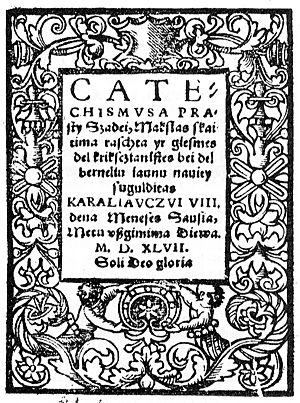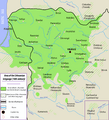Lithuanian language facts for kids
Quick facts for kids Lithuanian |
||||
|---|---|---|---|---|
| Lietuvių kalba | ||||
| Native to | Lithuania | |||
| Region | Europe | |||
| Native speakers | 2.96 million (Lithuania) 170,000 (Abroad) 3.13 million (Worldwide) (date missing) |
|||
| Language family |
Indo-European
|
|||
| Dialects |
Samogitian, Aukštaitian
|
|||
| Writing system | Roman script | |||
| Official status | ||||
| Official language in | ||||
| Recognised minority language in | ||||
| Regulated by | Commission of the Lithuanian Language | |||
| Linguasphere | 54-AAA-a | |||
|
||||
The Lithuanian language is a Baltic language. It is from Lithuania, spoken in a few countries in Europe, as well as in the Americas and Australia.
Lithuanian and Latvian are the only remaining Baltic languages. Both languages have many things in common. Lithuanian, however, adopted fewer words and phrases from German and other languages. However, long ago Lithuanian was affected by the Slavic languages, so the main barbarisms were replaced with Lithuanian words only in 1920, by Lithuanian philologist Jonas Jablonskis and others.

There are two main dialects of Lithuanian. Samogitian is the dialect mostly used in West Lithuania, the other, widely used in the whole country is Aukštaitian (High-landers' dialect). The standard Lithuanian comes from West-Aukštaitian.
The first book written in Lithuanian is Katekizmas by Martynas Mažvydas. It was published in East Prussia in 1547.
Images for kids
-
The oldest surviving manuscript in Lithuanian (c. 1503), rewritten from 15th century original text
-
A map of European languages (1741) with the first verse of the Lord's Prayer in Lithuanian
-
Lingwa Lietowia (Lithuanian language) mentioned among the European languages in a 15th century Chronik des Konstanzer Konzils written by Ulrich of Richenthal, dedicated to the Council of Constance (1414–1418)
-
The Grand Dictionary of the Lithuanian language consists of 20 volumes and contains more than half a million headwords.
-
Linguistic, ethnographic, and political map of Eastern Europe, by Casimir Delamarre (1868), which shows that the Lithuanian was the majority language around Vilnius and Kaunas.
-
Lithuanian language, mentioned as one of the languages of the participants of the Council of Constance in 1414–1418
-
Panegyric to Sigismund III Vasa, visiting capital Vilnius, first hexameter in Lithuanian language, 1589
-
Old Lithuanian language primer for kids (1783 edition), published in Vilnius, Grand Duchy of Lithuania
See also
 In Spanish: Idioma lituano para niños
In Spanish: Idioma lituano para niños











